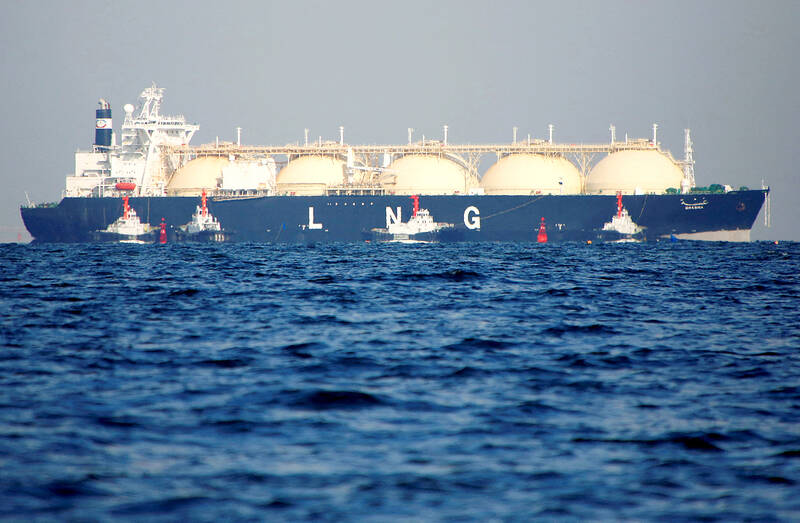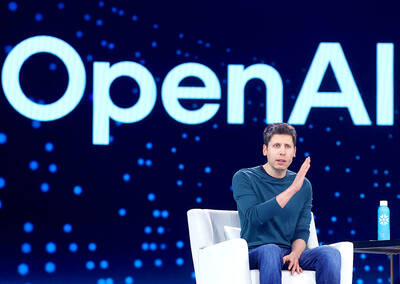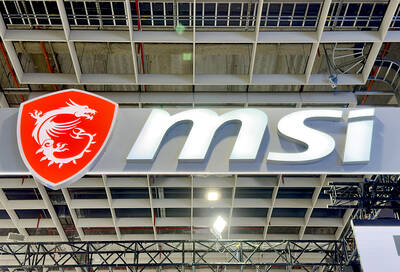When US President Donald Trump sat down to lunch with his Japanese counterpart on Feb. 7, talk turned quickly to how Tokyo could help realize a decades-old proposal to unlock gas in Alaska and ship it to US allies in Asia.
Trump and his energy czar — US Secretary of the Interior Doug Burgum — framed the venture as a way for Japan to replace Middle East energy shipments and address its trade imbalance with the US, two officials briefed on the closed-door talks said.
Japanese Prime Minister Shigeru Ishiba — eager to ensure a positive first meeting and stave off damaging US tariffs — struck an optimistic note about the Alaska liquefied natural gas (LNG) project, despite Tokyo’s doubts about its viability.

Photo: Reuters
Ishiba told Trump and Burgum that he hoped Japan could participate in the US$44 billion project, said the officials, granted anonymity due to the sensitivity of the talks.
Trump repeatedly mentioned the project in his public remarks after the lunch. Ishiba did not, and there was no reference to it in the official readout of the talks.
Reuters interviews with more than a dozen people, including current and former US and Asian officials, show how the Trump administration is moving to recast economic relations with East Asia by binding regional allies to Washington through increased investment in US fossil fuels, particularly LNG.
The US sales pitch seeks to tap into concerns in Asian capitals about tariffs and the security of sea lanes that carry their energy imports, Reuters found.
Details of the behind-the-scenes exchanges and specifics of the US approach have not been previously reported.
While the Alaska LNG proposal faces cost and logistical hurdles, Japan, South Korea, Taiwan and others are buying into the idea of increasing US gas imports more broadly, which could bolster the US economy and blunt the influence of China and Russia.
Japan’s participation in Trump’s emerging strategy would be critical: It is the world’s No. 2 LNG buyer, a major investor in energy infrastructure, and a trading hub with a glut of LNG that could help open new markets for US gas in Southeast Asia.
“If the Trump administration were to have its way, US LNG would flow in massive quantities to Japan and South Korea and then would flow downstream ... so that Southeast Asia would become economically dependent on the United States,” said Kenneth Weinstein, Japan chair at Hudson Institute, a conservative think tank. “It’s redrawing the map of energy dependence.”
In a joint statement with US Secretary of State Marco Rubio on Saturday last week, Japanese and South Korean foreign ministers agreed to strengthen energy security by “unleashing” the US’ “affordable and reliable energy,” particularly LNG. They did not mention Alaska.
White House National Security spokesman Brian Hughes said the US “produces some of the cleanest LNG in the world and we believe the Japanese can play an even bigger role in purchasing America’s abundant oil and gas.”
The Japanese Ministry of Foreign Affairs declined to comment on the accounts of the Ishiba-Trump meeting.
Japan’s trade minister plans to visit Washington next month to seek exemptions from Trump’s tariffs and discuss Japan’s plans to buy more US LNG, Japanese media reported on Thursday.
The idea of building a 1,300km pipeline linking gas fields on Alaska’s North Slope to an export terminal on its Pacific coast has long stuttered due to the high costs and harsh terrain.
However, expecting Trump might raise a project he has personally championed in the meeting with Ishiba, Japan was preparing to voice tentative support to win his favor and forestall trade friction, Reuters reported last month. They did not anticipate it would feature so highly on Trump’s agenda.
Over lunch with Trump and Burgum, the US asked Japan to consider infrastructure investments in Alaska LNG as well as long-term purchase agreements, officials briefed on the talks said.
The US side stressed the project’s proximity to Japan compared with the Middle East and the fact that shipments would avoid sensitive choke points, such as the Straits of Hormuz and Malacca, and the South China Sea, the officials said.
Additional purchases of US LNG could also help Asian allies reduce reliance on Russian gas, US Senator Dan Sullivan of Alaska.
Alaska LNG “was a big part of the discussion” with Ishiba, Sullivan, who was briefed on the talks, told Reuters.
At one point in the meeting, the US officials used maps to emphasize the strategic benefits of the Alaska project, Sullivan and another official said.
Project developers are trying to court investment from firms such as Inpex, a Tokyo-listed oil and gas exploration company whose largest stakeholder is the Japanese government, two other sources said.
A spokesperson for Inpex, which has not been previously linked to the Alaska plan, said it would not comment on “discussions or dealings with specific stakeholders.”
Japan obtains about one-10th of its LNG from the US, and similar proportions from Russia and the Middle East, according to the Japanese Ministry of Finance. Australia accounts for about 40 percent.
Hiroshi Hashimoto, senior analyst at Japan’s Institute of Energy Economics, said LNG imports from the US could reach 20 percent of Japan’s total over the next five to 10 years as existing contracts, including with Russia, roll off.
US LNG is largely shipped to Japan from the Gulf of Mexico, which Trump recently renamed to the Gulf of America, via the Panama Canal or the long way around past Africa and through the Indian Ocean.
There are no LNG export terminals on the US west coast — a more direct route to Asia — although Sempra’s Costa Azul project in Mexico, fed by US gas, is expected to start commercial operations next year.
Of the 119.8 billion cubic meters of LNG the US shipped last year, more than one-third went to Asia, according to LSEG data.
Beyond Japan, Trump’s energy security argument seems to be landing elsewhere in Asia, especially with trade tariffs looming. Indian Prime Minister Narendra Modi made a similar gas pledge in a meeting with Trump this month.
Taiwan is also considering more US energy purchases, including LNG from Alaska.
Increasing Taiwan’s dependence on US energy could help deter China from taking aggressive steps such as naval blockades, said Landon Derentz, who was a senior US energy official during Trump’s first term.
With US supplies, “in some ways you’re contracting for a security guarantee that the United States is going to be an advocate in the event of a conflict in making sure that supply arrives,” he said.
South Korea, too, is weighing investing in Alaskan LNG and other US energy projects, two South Korean officials told Reuters.
Seoul hoped for concessions from Trump in return, one said.
A spokesperson for the South Korean Ministry of Trade, Industry and Energy said Seoul was exploring ways to strengthen energy security with the US.
US Senator Bill Hagerty, who served as ambassador to Tokyo in the first Trump administration, said he would like Japan, which already trades its surplus gas, to become the key distribution hub for US-origin LNG.
“Whether it’s from Alaska, Louisiana or Texas, America can work very closely with Japan to create the type of energy security bonds that will be great for our nations’ economies and for our national security,” he said.

DIVIDED VIEWS: Although the Fed agreed on holding rates steady, some officials see no rate cuts for this year, while 10 policymakers foresee two or more cuts There are a lot of unknowns about the outlook for the economy and interest rates, but US Federal Reserve Chair Jerome Powell signaled at least one thing seems certain: Higher prices are coming. Fed policymakers voted unanimously to hold interest rates steady at a range of 4.25 percent to 4.50 percent for a fourth straight meeting on Wednesday, as they await clarity on whether tariffs would leave a one-time or more lasting mark on inflation. Powell said it is still unclear how much of the bill would fall on the shoulders of consumers, but he expects to learn more about tariffs

NOT JUSTIFIED: The bank’s governor said there would only be a rate cut if inflation falls below 1.5% and economic conditions deteriorate, which have not been detected The central bank yesterday kept its key interest rates unchanged for a fifth consecutive quarter, aligning with market expectations, while slightly lowering its inflation outlook amid signs of cooling price pressures. The move came after the US Federal Reserve held rates steady overnight, despite pressure from US President Donald Trump to cut borrowing costs. Central bank board members unanimously voted to maintain the discount rate at 2 percent, the secured loan rate at 2.375 percent and the overnight lending rate at 4.25 percent. “We consider the policy decision appropriate, although it suggests tightening leaning after factoring in slackening inflation and stable GDP growth,”

Meta Platforms Inc offered US$100 million bonuses to OpenAI employees in an unsuccessful bid to poach the ChatGPT maker’s talent and strengthen its own generative artificial intelligence (AI) teams, OpenAI CEO Sam Altman has said. Facebook’s parent company — a competitor of OpenAI — also offered “giant” annual salaries exceeding US$100 million to OpenAI staffers, Altman said in an interview on the Uncapped with Jack Altman podcast released on Tuesday. “It is crazy,” Sam Altman told his brother Jack in the interview. “I’m really happy that at least so far none of our best people have decided to take them

PLANS: MSI is also planning to upgrade its service center in the Netherlands Micro-Star International Co (MSI, 微星) yesterday said it plans to set up a server assembly line at its Poland service center this year at the earliest. The computer and peripherals manufacturer expects that the new server assembly line would shorten transportation times in shipments to European countries, a company spokesperson told the Taipei Times by telephone. MSI manufactures motherboards, graphics cards, notebook computers, servers, optical storage devices and communication devices. The company operates plants in Taiwan and China, and runs a global network of service centers. The company is also considering upgrading its service center in the Netherlands into a